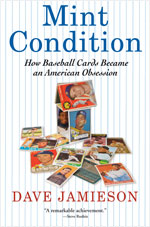In this excerpt from the book Mint Condition: How Baseball Cards Became an American Obsession, Dave Jamieson explains how baseball cards first became seen as promising investments, setting the stage for a decade of speculation and overproduction:
Around the mid-1970s, a small cabal of serious baseball card collectors grew wise to the fact that their cards had become valuable. Cards had almost always had prices attached to them, even when prolific collector and cataloger Jefferson Burdick began sending out his Card Collectors Bulletin in the 1930s. But cards that had been worth a few cents were now worth a few bucks, and some of the rarer specimens, such as the T206 Honus Wagner, were commanding hundreds and occasionally thousands of dollars apiece. The number of trade shows sprouting up in the East and the Midwest testified to a growing market. By this time, the most aggressive card collectors had started crisscrossing the country in search of private hoards of cardboard that could be snatched up at bargain prices. Unlike school kids, these men were well-aware of baseball cards’ status as a commodity–albeit an undervalued one–and many of these enthusiasts could credit their early transactions with turning them into wealthy men later in life.
